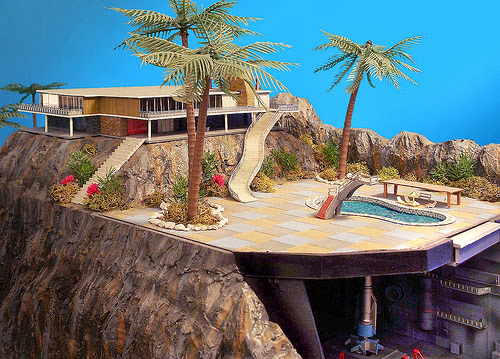Dream Homes
I went to see Christopher Nolan's Inception a couple of weeks ago, and enjoyed it very much. The key idea in the film is that of 'dream architecture' – be that the map of the dream and stuctures within that, or as a metaphor for storytellying and creating imaginary worlds.
In the movie our daring heist team dive into the subconscious of their victim to extract, or in this case, plant an idea. The architecture of the dream they create has to be complex, like a maze, so that they can fool the dreamer by pulling them deeper and deeper into the game. This requires them to create landscapes which the dreamer will then populate.
There are many debts here: a heavy one to Neal Stephenson, whose complex visions of cyberspace made the Matrix films possible a decade or so ago. There's also a much less whimsical, human and profound use of the idea of dreamscapes and the subconscious than that depicted in Gondry and Kaufman's Eternal Sunshine of the Spotless Mind. It is, to some extent, Eternal Sunshine reskinned as a thriller with all of the complexities and ambiguities of the human mind massively simplified in the process. And there's no end of Baudrillardian psychogeography going on here too: just as old Baldy argues that because of the way most people 'consumed' it via TV etc, the Gulf war did not take place (not a easy sell to people who were there, lost relatives or limbs, etc), so Inception takes that cold, abstract idea and turns it into a story. And what it makes is curiously bloodless for an action thriller, where the dead are simply dream figures who can come and go at the whim of the dreamer.
Could Inception have been made, or even conceived, without CGI? Sure, people like Philip K Dick or Borges have written mindfucking metanarratives for years in book form, and cinema has had a century of brilliantly complex fantasies, such as The Spirit of the Beehive or Metropolis. Yet Nolan couldn't have thought of making this film with the FX from A Matter of Life and Death, say, brilliantly sophisticated and elegant though they are. Or, indeed, with the stop frame skills of Harryhausen's Jason and the Argonauts. Inception is a film of its time partly because it relies on the language of computer programming and game architecture to create its story and its world, and that can only be convincingly represented with CGI. (Gondry may execute all of the special effects in his films in camera, but the ideas behind them are the subversion of the glossy end product of CGI that Nolan so embraces.)
But more than game architecture, the film relies on another computer-era idea as a central premise: that architects now design and plan buildings in 3D in much the same way that game architects knock up some generic backdrops for their characters to run about in shooting hookers and aliens. Architecture is shown to be as push button as the FX allow: folding back on itself, endlessly replicating and evolving from a few basic commands. Nolan enjoys the cheap thrill of playing with Escher paradoxes and breaking the rules of logic. But there's a more interesting layer here too. He uses architecture to represent memory, be it a dolls house, a childhood home or an entire imaginary city. Much as computer modeling allows urban planners and architects to remodel buildings, streets and districts and create previously impossible structures such as the Shard, simultaneously destroying and creating, so Nolan and the characters in his film can build up 3D modeled worlds and destroy them with relative ease.
The characters spend a lot of time rebuilding the past and then destroying it. It's also noticeable that the different layers to the dreams have different architecture. The first is the early 20th century city, with its sturdy bridges and blocks. Then there's the Miesian shiny midcentury hotel complex. Beyond that there's a Corbusian brutalist concrete hospital fortress, and eventually a high tech 'limbo' which the characters want to live in, surrounded by little islands of old buildings reconstructed in great detail. And with each of these worlds, the passing of time destroys them, some quicker than others. Entropy, concrete cancer, fashion: these dream landscapes face the same problems as the real cities we live in, with their mixture of perfectly preserved old buildings and crumbling new ones. To keep these worlds propped up and new takes a great deal of effort, money and interest. And increasingly we can remodel and remake the more recent additions without anyone batting an eyelid, because 3D design tools allow us to play with cities as if they were games inside someone's head.
In the movie our daring heist team dive into the subconscious of their victim to extract, or in this case, plant an idea. The architecture of the dream they create has to be complex, like a maze, so that they can fool the dreamer by pulling them deeper and deeper into the game. This requires them to create landscapes which the dreamer will then populate.
There are many debts here: a heavy one to Neal Stephenson, whose complex visions of cyberspace made the Matrix films possible a decade or so ago. There's also a much less whimsical, human and profound use of the idea of dreamscapes and the subconscious than that depicted in Gondry and Kaufman's Eternal Sunshine of the Spotless Mind. It is, to some extent, Eternal Sunshine reskinned as a thriller with all of the complexities and ambiguities of the human mind massively simplified in the process. And there's no end of Baudrillardian psychogeography going on here too: just as old Baldy argues that because of the way most people 'consumed' it via TV etc, the Gulf war did not take place (not a easy sell to people who were there, lost relatives or limbs, etc), so Inception takes that cold, abstract idea and turns it into a story. And what it makes is curiously bloodless for an action thriller, where the dead are simply dream figures who can come and go at the whim of the dreamer.
Could Inception have been made, or even conceived, without CGI? Sure, people like Philip K Dick or Borges have written mindfucking metanarratives for years in book form, and cinema has had a century of brilliantly complex fantasies, such as The Spirit of the Beehive or Metropolis. Yet Nolan couldn't have thought of making this film with the FX from A Matter of Life and Death, say, brilliantly sophisticated and elegant though they are. Or, indeed, with the stop frame skills of Harryhausen's Jason and the Argonauts. Inception is a film of its time partly because it relies on the language of computer programming and game architecture to create its story and its world, and that can only be convincingly represented with CGI. (Gondry may execute all of the special effects in his films in camera, but the ideas behind them are the subversion of the glossy end product of CGI that Nolan so embraces.)
But more than game architecture, the film relies on another computer-era idea as a central premise: that architects now design and plan buildings in 3D in much the same way that game architects knock up some generic backdrops for their characters to run about in shooting hookers and aliens. Architecture is shown to be as push button as the FX allow: folding back on itself, endlessly replicating and evolving from a few basic commands. Nolan enjoys the cheap thrill of playing with Escher paradoxes and breaking the rules of logic. But there's a more interesting layer here too. He uses architecture to represent memory, be it a dolls house, a childhood home or an entire imaginary city. Much as computer modeling allows urban planners and architects to remodel buildings, streets and districts and create previously impossible structures such as the Shard, simultaneously destroying and creating, so Nolan and the characters in his film can build up 3D modeled worlds and destroy them with relative ease.
The characters spend a lot of time rebuilding the past and then destroying it. It's also noticeable that the different layers to the dreams have different architecture. The first is the early 20th century city, with its sturdy bridges and blocks. Then there's the Miesian shiny midcentury hotel complex. Beyond that there's a Corbusian brutalist concrete hospital fortress, and eventually a high tech 'limbo' which the characters want to live in, surrounded by little islands of old buildings reconstructed in great detail. And with each of these worlds, the passing of time destroys them, some quicker than others. Entropy, concrete cancer, fashion: these dream landscapes face the same problems as the real cities we live in, with their mixture of perfectly preserved old buildings and crumbling new ones. To keep these worlds propped up and new takes a great deal of effort, money and interest. And increasingly we can remodel and remake the more recent additions without anyone batting an eyelid, because 3D design tools allow us to play with cities as if they were games inside someone's head.










Brilliant article, and nice to read about the architectural angle! I loved the film too, and have no truck with those who lazily disparage it because it's a "Hollywood blockbuster". Though that's usually enough reason in itself...
ReplyDeleteI am also worried about the Dalek theory - someone should do something.
Mike
Cheers Mike! I expected the Sharlek (as I am now clunkily calling it) to maraud through London on Christmas day but no such luck...
ReplyDelete